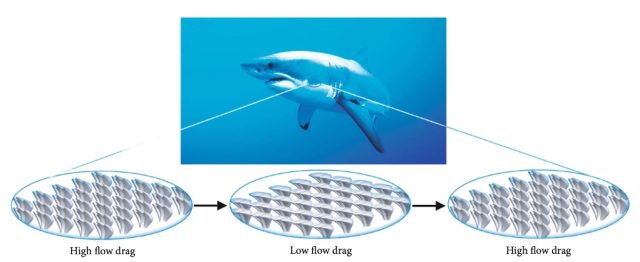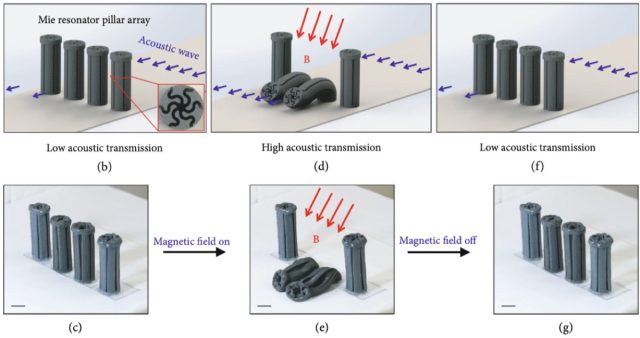So-called "acoustic metamaterials" are specifically designed to control and manipulate sound waves, usually for the purpose of dampening or transmitting sound. But such an acoustic device can only perform the function for which it was created, such as dampening outgoing sound in a submarine, for example. That same device could not be repurposed to communicate with another passing vessel should the situation aboard the submarine require it; a different acoustic device must be used, one developed expressly for that purpose.
Now a team of scientists from the University of Southern California have developed an acoustic metamaterial that can switch between different uses by applying carefully tailored magnetic fields, according to a new paper in the journal Research. The structure of these new metamaterials was inspired by the unusual structure of shark skin. They can be used to mimic the function of switches, logic gates, or diodes, raising the possibility of a sound "computer."
A "metamaterial" is technically defined as any material whose microscopic structure can bend light in ways it doesn't normally bend. That property is called an index of refraction, i.e., the ratio between the speed of light in a vacuum and how fast the top of the light wave travels.
Natural materials have a positive index of refraction; certain manmade metamaterials—first synthesized in the lab in 2000—have a negative index of refraction, meaning they interact with light in such a way as to bend light around even very sharp angles. (This makes them ideal for cloaking applications, since any "invisibility cloak" must be able to bend electromagnetic waves around whatever it's supposed to be cloaking.) Acoustic metamaterials are conceptually much the same, except for sound waves rather than light.
A shark's skin feels smooth if you stroke from nose to tail. Reverse the direction, however, and it feels like sandpaper. That's because of tiny translucent scales, roughly 0.2 millimeters in size, called "denticles" (because they strongly resemble teeth) all over the shark's body, especially concentrated in the animal's flanks and fins. It's the secret to how they can swim so fast. Mako sharks, for instance, can swim as fast as 70 to 80mph thanks to a distinct passive "bristling" aspect on some of their scales.
Last year, we reported on University of Alabama engineer Amy Lang's work with biologists at the University of South Florida to image shark skin and map out the scales, noting particularly how many of the scales were capable of this passive bristling and the angles at which such bristling occurs. They found that near the flanks and fins, the scales are much more flexible. That has a profound effect on the degree of pressure drag the mako shark encounters as it swims.
The shark skin denticles can flex at angles more than 40 degrees from its body—but only in the direction of reversing flow (i.e., from tail to nose). This controls the degree of flow separation, similar to the dimples on a golf ball. The dimpling, or scales in the case of the mako shark, help maintain attached flow around the body, reducing the size of the wake. A dimpled golf ball will travel 30-percent farther when hit than if the same ball were smooth. The same pressure drag reduction holds true for smooth and scaled shark skin.

That built-in ability to essentially "tune" the degree of drag is what drew the attention of the USC scientists, who thought that an acoustic metamaterial might be built along similar lines to achieve multiple properties with a single acoustic device. “With traditional acoustic metamaterials, you create one structure and you achieve one property. With this new smart material, we can achieve multiple properties with just one structure,” co-author Qiming Wang said.
They molded the pillars out of liquid silicone rubber (to ensure flexibility) combined with iron nanoparticles, curing the mixture for about five hours before removing them from the molds. The secret to blocking or transmitting sound lies in the structure: in this case, the space between an array of pillars. Put the pillars close together, and they will trap sound waves rather than letting them pass through. Place them farther apart, and the sound can propagate through the material.
The iron nanoparticles make the material bend in response to external magnetic fields. “We use the external magnetic field to bend the pillar and unbend the pillar to achieve this sort of state switching,” co-author Kyung Hoon Lee said. That allows the material to switch back and forth between damping and transmitting sound waves.

This has some useful potential applications. Wang et al. were able to get the material to mimic a switch, for instance, such as those found in noise-cancelling headphones. The pillars can be bent to allow outside noise to pass through, while turning the magnetic field off returns them to their upright position, blocking external noise. They also found their new material could mimic a diode, in which sound waves can only travel one way. Unlike conventional acoustic metamaterials, this new class can switch between one-way and two-way transmission of sound just by tuning the magnetic field—useful for sonic camouflage (e.g., a sonic "invisibility cloak" for submarines), for instance.
Even more intriguing, the team was able to mimic simple decision-making logic gates (an AND gate operator and an OR gate operator) to respond to different conditions. For instance, according to Wang, a submarine that wanted an acoustic device to trigger (or not trigger) an attack command—or, alternatively, to flee—would usually need to have a device to create an operator for each condition using standard acoustic metamaterials, which can't be changed once they have been created. This new class, however, allows one to switch between AND and OR gate operators on demand by tuning the magnetic field.
So far, the USC team has only tested their metamaterial in air. The next step is to test how well it performs in water, using sound waves in the ultrasonic frequency range. Granted, the shark skin that inspired the new material works well in water, less so in air, but it's more a question of how well the magnetic field manipulation works in a different medium. “Rubber is hydrophobic, so the structure won’t change, but we need to test if the materials will still have tunability under an external magnetic field,” Wang said.
DOI: Research, 2020. 10.34133/2020/4825185 (About DOIs).
Listing image by K.H. Lee et al./Research
reader comments
16